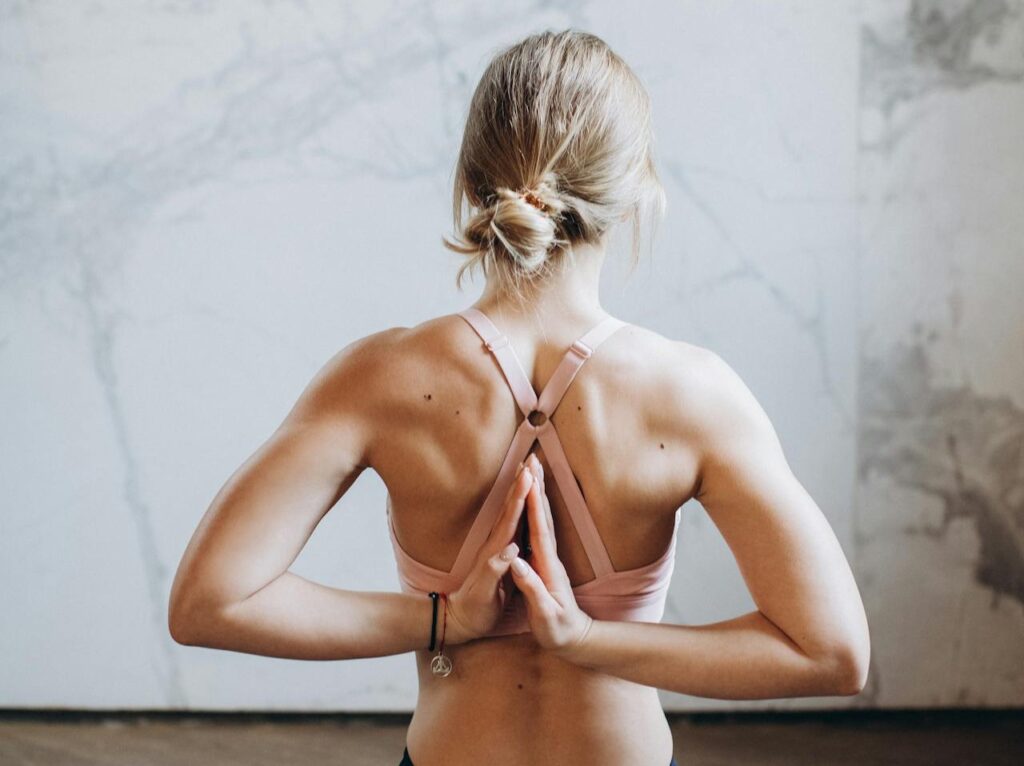Backbends are among the most transformative yet intimidating poses in yoga practice. Whether you’re drawn to the heart-opening benefits or simply want to improve your spinal mobility, learning backbends safely is essential for long-term success. This comprehensive guide will take you from your very first gentle backbend to building a sustainable progression that honors your body’s unique needs.
The Life-Changing Benefits of Backbending Practice
Physical Benefits
Backbends offer remarkable physical advantages that extend far beyond the yoga mat:
• Spinal health and mobility: Regular backbending counteracts the forward hunching from desk work, improving spinal extension and reducing back pain
• Posture improvement: Strengthens the posterior chain muscles that support proper alignment
• Shoulder and chest opening: Releases tension from rounded shoulders and tight chest muscles
• Core strengthening: Engages deep abdominal muscles to protect the lower back during extension
• Hip flexor flexibility: Lengthens chronically tight hip flexors from prolonged sitting
Emotional and Energetic Benefits
The heart-opening nature of backbends creates profound emotional shifts:
• Stress relief: Opens the chest and encourages deeper breathing, activating the parasympathetic nervous system
• Confidence building: The vulnerable nature of backbends cultivates courage and self-trust
• Energy boost: Stimulates the heart chakra (Anahata), promoting feelings of love and compassion
• Mood enhancement: The chest opening can help release stored emotions and create feelings of joy
Essential Safety Guidelines for Backbend Practice
Pre-Practice Preparation
Before attempting any backbend, proper preparation is non-negotiable:
• Warm up thoroughly: Spend 10-15 minutes warming the spine with gentle movements like cat-cow stretches
• Open hip flexors: Use low lunges and hip flexor stretches to prepare the front body
• Activate your core: Engage deep abdominal muscles to protect the lower back
• Mobilize shoulders: Perform arm circles and shoulder rolls to prepare the upper body
Critical Safety Rules
• Never force a backbend: Progress gradually and listen to your body’s signals
• Avoid consecutive deep backbends: Limit intense backbends to prevent overstretching
• Breathe consistently: Maintain steady, deep breathing throughout each pose
• Use props when needed: Blocks, bolsters, and straps can make poses more accessible
• Practice counter-poses: Always follow backbends with gentle forward folds or twists
When to Avoid Backbends
Certain conditions require modified or avoided backbend practice:
• Pregnancy (especially after first trimester)
• Recent back, neck, or shoulder injuries
• Herniated discs or spinal conditions
• High blood pressure or heart conditions
• Severe osteoporosis
8 Essential Beginner Backbends: Your Progressive Journey
Level 1: Foundation Poses
1. Cow Pose (Bitilasana)
Start on hands and knees in tabletop position. On an inhale, arch your back gently, lifting your chest and tailbone toward the ceiling. This gentle spinal extension warms up the entire spine.
Hold for: 5-8 breaths
Focus: Gentle, controlled movement
2. Sphinx Pose (Salamba Bhujangasana)
Lie face down with forearms on the ground, elbows under shoulders. Press forearms down and lift your chest, creating a gentle backbend through the upper spine.
Hold for: 30-60 seconds
Progression tip: Gradually walk elbows forward to deepen the pose
3. Supported Fish Pose
Place a bolster or rolled blanket under your shoulder blades. Lie back and allow your chest to open passively. This restorative backbend is perfect for beginners.
Hold for: 2-5 minutes
Benefits: Gentle heart opening without strain
Level 2: Active Engagement
4. Cobra Pose (Bhujangasana)
From lying face down, place palms under shoulders. Press hands down and lift your chest, keeping hips grounded. Focus on using back muscles rather than pushing with arms.
Hold for: 15-30 seconds
Common mistake: Pushing too hard with hands instead of engaging back muscles
5. Locust Pose (Salabhasana)
Lie face down with arms alongside your body. On an inhale, lift your chest, arms, and legs simultaneously. This pose strengthens the entire posterior chain.
Hold for: 10-20 seconds
Variation: Lift only chest and arms if full pose is too intense
6. Bridge Pose (Setu Bandhasana)
Lie on your back with knees bent, feet hip-width apart. Press feet down and lift your hips, creating a bridge shape. This foundational backbend builds strength and flexibility.
Hold for: 30-60 seconds
Progression: Place a block between thighs to engage inner legs
Level 3: Deeper Opening
7. Camel Pose Preparation
Kneel with shins parallel, hands on lower back. Gently arch backward, keeping hips moving forward. Only reach for heels if you can maintain the chest opening.
Hold for: 15-30 seconds
Safety note: Keep one hand on lower back if reaching for heels feels unstable
8. Supported Wheel Pose
Place a bolster or block under your shoulder blades while in bridge pose. This supported version of wheel pose allows you to experience deeper backbending safely.
Hold for: 30-60 seconds
Benefits: Builds confidence for eventual full wheel pose
Understanding Backbend Anatomy: Why Proper Alignment Matters
The Role of Your Spine
Your spine has natural curves that backbends should honor:
• Cervical spine: Maintain neutral neck position to avoid compression
• Thoracic spine: This naturally less mobile section benefits most from backbending
• Lumbar spine: Protect this vulnerable area by engaging core muscles
Key Muscle Groups
Understanding which muscles to engage helps prevent injury:
• Erector spinae: These back muscles initiate the backbend movement
• Glutes: Engage to protect the lower back and create hip stability
• Core muscles: Deep abdominals support the spine during extension
• Shoulder stabilizers: Keep shoulders away from ears and create stable foundation
Common Mistakes and How to Fix Them
Mistake 1: Collapsing into the Lower Back
The problem: Allowing all the bend to happen in the lumbar spine
The solution: Engage core muscles and focus on opening the chest and upper back
Mistake 2: Holding Your Breath
The problem: Tension and breath-holding limit the pose’s benefits
The solution: Maintain steady, deep breathing throughout each backbend
Mistake 3: Forcing the Pose
The problem: Pushing beyond your current capacity creates injury risk
The solution: Progress gradually and honor your body’s current limitations
Mistake 4: Neglecting Warm-Up
The problem: Jumping into backbends without preparation
The solution: Always spend adequate time warming up the spine and surrounding muscles
Breathing Techniques for Backbends
The Backbend Breath Pattern
Proper breathing enhances both safety and depth in backbends:
- Inhale to initiate: Use the inhale to lift and create space
- Exhale to deepen: Allow the exhale to help you settle into the pose
- Maintain rhythm: Keep breathing steady throughout the hold
- Use breath to exit: Exhale to slowly release from the pose
Pranayama for Heart Opening
• Three-part breath: Helps calm the nervous system before intense backbends
• Heart-centered breathing: Visualize breathing into the heart space during backbends
• Extended exhales: Use longer exhales to activate the relaxation response
Creating Your Personal Progression Plan
Week 1-2: Foundation Building
Focus on gentle poses like Sphinx, supported Fish, and gentle Cobra variations. Practice 3-4 times per week, holding poses for shorter durations.
Week 3-4: Strength Development
Add Bridge pose and Locust pose to your practice. Begin holding poses for longer periods and focus on proper muscle engagement.
Week 5-8: Expanding Your Practice
Introduce Camel preparation and supported Wheel variations. Continue building strength while gradually increasing flexibility.
Month 2-3: Deepening Practice
Work toward unsupported versions of poses and begin exploring more challenging variations based on your progress.
Long-term Goals (3+ months)
Consider working toward poses like Wheel, King Pigeon, or Scorpion with proper guidance and consistent practice.
Props and Modifications for Every Body
Essential Props for Beginners
• Yoga blocks: Support hands in poses like Camel or create height under hips
• Bolsters: Provide passive support in restorative backbends
• Straps: Help reach hands to feet in binding poses
• Blankets: Offer cushioning and warmth during longer holds
Modifications for Different Needs
For tight shoulders: Use blocks under hands in Cobra pose
For sensitive knees: Place blanket under knees in kneeling backbends
For lower back sensitivity: Focus on upper back opening and use props for support
For limited mobility: Emphasize gentle, supported variations
Sequencing Your Backbend Practice
Ideal Warm-Up Sequence (10-15 minutes)
- Cat-Cow stretches (2 minutes)
- Low lunge hip flexor stretches (2 minutes each side)
- Gentle spinal twists (1 minute each side)
- Shoulder rolls and arm circles (2 minutes)
- Core activation exercises (3 minutes)
Sample Beginner Backbend Sequence (20-30 minutes)
- Sphinx Pose (1 minute)
- Cobra Pose (30 seconds, repeat 3 times)
- Bridge Pose (45 seconds, repeat 3 times)
- Locust Pose (20 seconds, repeat 3 times)
- Supported Fish Pose (3-5 minutes)
Essential Cool-Down (5-10 minutes)
- Child’s Pose (2 minutes)
- Gentle spinal twist (1 minute each side)
- Knees to chest (1 minute)
- Savasana (3-5 minutes)
Building Confidence in Your Practice
Start Small, Dream Big
Remember that every expert was once a beginner. Your first Cobra pose is just as valuable as an advanced practitioner’s Wheel pose. Focus on:
• Consistency over intensity: Regular gentle practice trumps occasional extreme efforts
• Quality over quantity: Better to do fewer poses with proper alignment
• Patience with progress: Flexibility and strength develop gradually over time
• Celebrating small wins: Acknowledge every improvement, no matter how minor
Finding Your Edge
Learning to work at your appropriate edge is crucial for safe progression:
• 50-70% effort: Work at moderate intensity, never forcing
• Sensation vs. pain: Distinguish between productive stretch and harmful pain
• Daily variations: Accept that your capacity changes day to day
• Rest when needed: Honor your body’s need for recovery
Frequently Asked Questions
How often should beginners practice backbends?
Start with 2-3 times per week, allowing rest days between sessions. As your body adapts, you can gradually increase frequency while always listening to your body’s signals.
Is it normal to feel emotional during backbends?
Yes, absolutely. Backbends open the heart chakra and can release stored emotions. If you feel emotional during practice, breathe deeply and allow the feelings to pass naturally.
How long does it take to see progress in backbends?
Most beginners notice increased flexibility and strength within 4-6 weeks of consistent practice. However, everyone progresses at their own pace, so focus on your personal journey rather than comparing to others.
Can I practice backbends if I have a desk job?
Yes, backbends are especially beneficial for people who sit frequently. Start gently and focus on poses that counteract forward head posture and rounded shoulders.
What should I do if I feel pain during a backbend?
Stop immediately and come out of the pose. Pain is different from the sensation of stretching and should never be ignored. Consider working with a qualified instructor to assess your alignment.
Your Journey Forward: Embracing the Process
Backbending is ultimately about more than physical flexibility—it’s a practice of opening your heart to life’s possibilities. As you embark on this journey, remember that progress isn’t always linear. Some days you’ll feel strong and open, while others may require gentler approaches.
The key to successful backbend practice lies in consistency, patience, and self-compassion. Start where you are, use what you have, and do what you can. Your body will gradually adapt and open, revealing new depths of strength and flexibility you never knew existed.
Whether your goal is to eventually achieve advanced poses like Wheel or simply to counteract the effects of modern life, this progressive approach will serve you well. Trust the process, honor your body’s wisdom, and enjoy the transformative journey of opening your heart through backbend practice.
Remember: every backbend is an opportunity to practice courage, cultivate strength, and open your heart a little wider to the world around you.



